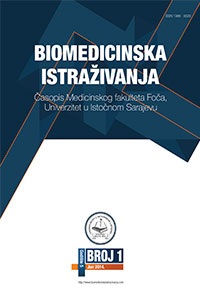A rare thyroid disorder mimicking mitochondrial disease
DOI:
https://doi.org/10.5937/BII2101109SAbstract
Introduction. Patients affected with Allan-Herndon-Dudley syndrome
(AHDS) have a deficiency of monocarboxylate transporter 8 (MCT8), a
protein primarily responsible for the transport of triiodothyronine (T3)
into the brain. This X-linked disorder affects almost exclusively males with
clinical presentation encompassing developmental delay, axial hypotonia,
dystonia, poor head control, quadriplegia and absence of speech.
Case reports. Patient 1 is a male child referred to a hospital investigation
at 11 months due to severe developmental delay and elevated
blood ammonia level (163 mcmol/L). Hypotonia and dystonic movements
were noted at admission, with facial dysmorphic features. Laboratory
findings revealed increased blood lactate (17.2 mmol/L), alanine
(533 mcmol/L) and ammonia (391 mcmol/L) concentrations. Serum
creatine-kinase levels showed substantial increase over the course of
hospitalization up to 6,855 IU/L. Clinical exome sequencing detected
a novel hemizygous frameshift insertion c.1456insC in gene SLC16A2,
predicted to cause loss of normal protein function either through protein
truncation or nonsense-mediated mRNA decay. Segregation genetic
testing of the family members revealed that mother, maternal
uncle and maternal grandmother carry the same mutation in SLC16A2.
The boy`s mother experienced learning difficulties through childhood
while maternal uncle is severely affected by AHDS. Patient 2 is a boy
referred to clinical geneticist due to severe psychomotor delay of unknown
etiology. Moderate serum lactate elevation was the only laboratory
abnormality during initial investigations. Diagnosis of AHDS was
established by clinical exome sequencing, and subsequent hormonal
evaluation revealed increased triiodothyronine (T3) level which corresponds
well to genetic diagnosis.
Conclusion. Presence of lactic acidosis and/or hyperammonemia in
children with severe developmental delay is not specific for inborn disorders
of energy production, such as mitochondrial disease. Clinicians
should consider thyroid hormones profiling in cases of unexplained
severe developmental delay in male children, especially if associated
with axial hypotonia and dystonic movements.

